qabalahtarotwesternhermeticmagickeli.mystrikingly.com
Above all things know thyself!
Khadroma Tibetan Dakini.
The Daughters of Kali Ma-Fierce protectors.
In the Western Hermetic Mysteries and Qabalah, many cultural philosophies are linked together in an all-encompassing gnosis. I have often called upon the Hindu Sanskrit Dakini and/or the Tibetan Khadroma (chanted in three syllables-KHA DO MA.) for protection, fierce guardianship, and psychopomps work on the Astral plane. These "sky dancers" as especially proficient at banishing evil forces and/or parasitic astral influences.
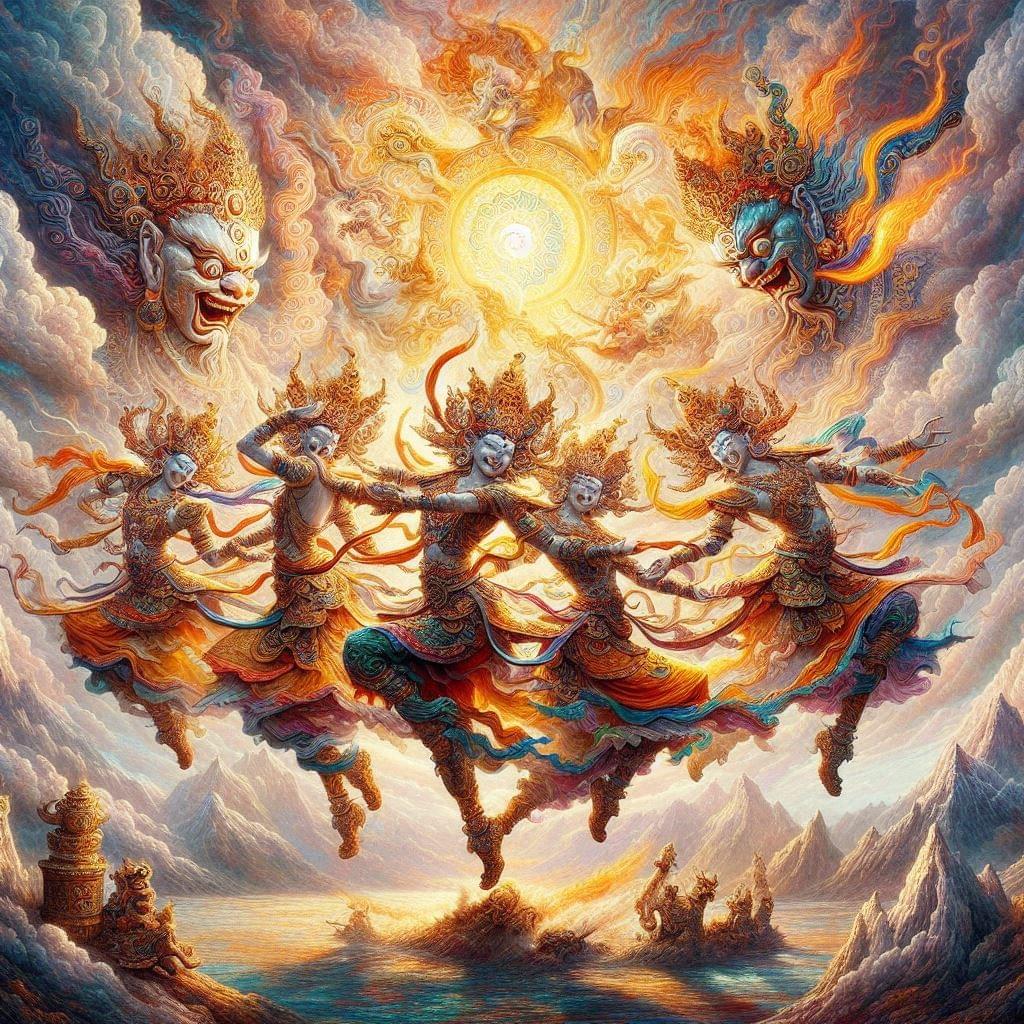
Below is an overview of who the Ka Dro Ma (commonly transliterated as Khandroma or Ḍākinī in Sanskrit but chanted in three syllables for invocation) as they are in the Tibetan context, followed by a suggested Western Hermetic-style invocation ritual that draws on the language and structure familiar to many practitioners of the Western Occult tradition. While such a blending of traditions can be spiritually meaningful, it is also important to maintain respect for both lineages—Tibetan Vajrayāna and Western Hermetic Qabalah—by recognizing that these are distinct paths. The ritual offered here is an example of how one might respectfully “bridge” them in personal practice, but it is not necessarily a traditional Tibetan method of calling upon the Kha Dro Ma.
Who Are the Kha Dro Ma?
Etymology and Origins
- The Tibetan term Kha Dro Ma (also spelled Khadroma) is synonymous with Khandroma (མཁའ་འགྲོ་མ་) and correlates with Sanskrit Ḍākinī. Literally, Kha (or *Mkha’) often means “sky,” “space,” or “heaven,” and Dro (འགྲོ་) means “to go” or “to move.” Hence, Kha Dro Ma are commonly referred to in English as “sky dancers” or “space-goers.”
- In Tibetan Buddhism—particularly Vajrayāna—Kha Dro Ma/Ḍākinīs are embodiments of feminine wisdom energy. They can manifest as protectors, teachers, guides, or even fierce guardians, depending on the practitioner’s karmic and spiritual circumstances.
Protective and Psychopomp Role
- Protection: Certain wrathful or semi-wrathful Ḍākinīs are known to defend practitioners from malevolent forces (both external and internal).
- Psychopomp: In some practices, they help guide souls through the transitional spaces after death, or assist the living in navigating subtle realms.
- Inner Transformation: As expressions of prajñā (wisdom), they often represent the power to cut through illusions and attachments, thus catalyzing deep inner change.
Nature and Symbolism
- They are often depicted with a dynamic, dance-like posture—symbolizing the free, spacious movement of enlightened energy.
- Their sometimes fierce or wrathful appearances remind us that spiritual truth can be unyielding; they shatter our delusions to protect the authentic unfolding of our consciousness.
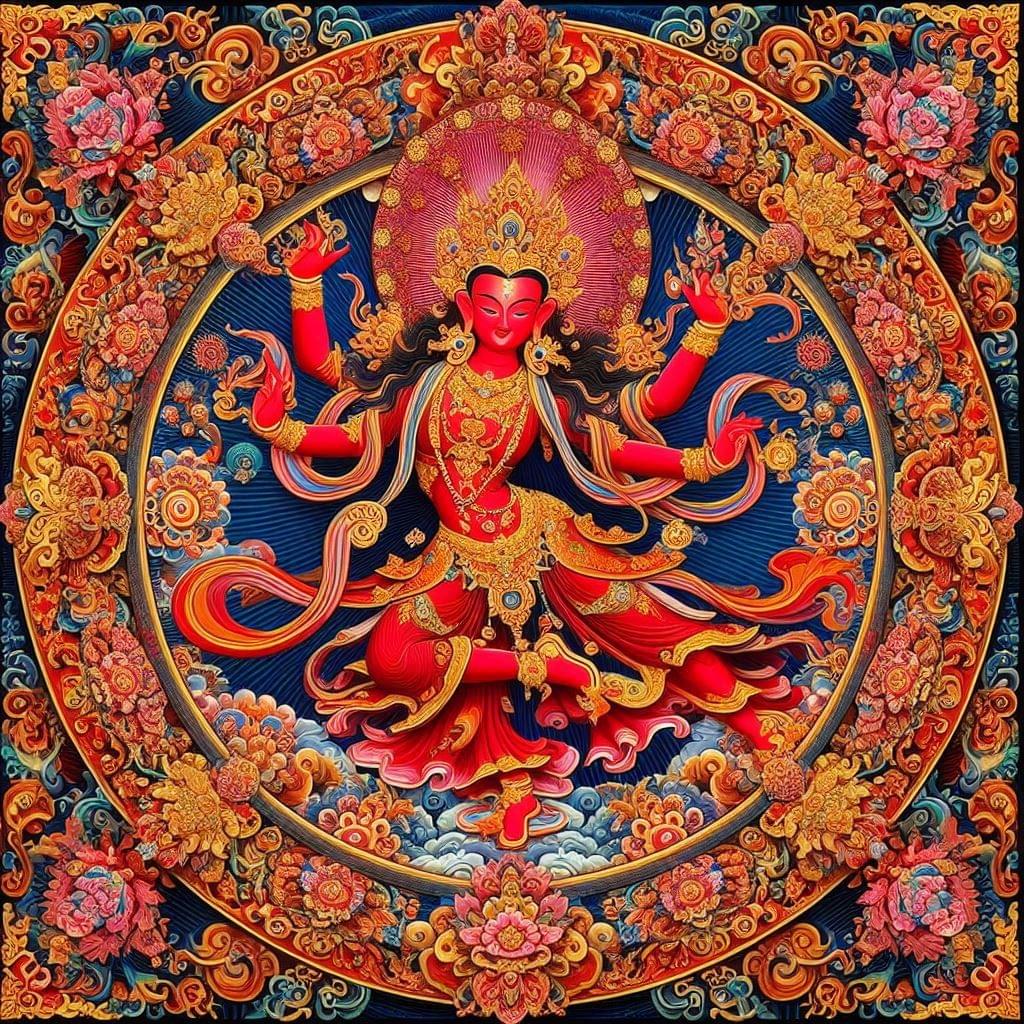
In Tibetan Vajrayāna Buddhism, the term Kha Dro Ma (Tib. མཁའ་འགྲོ་མ་; Sanskrit Ḍākinī) is quite broad, referring to myriad enlightened feminine energies that can appear as peaceful, wrathful, or somewhere in between. Among these Ḍākinīs, Vajrayoginī (often depicted as the dancing red Yoginī) is considered a preeminent, or even supreme, Ḍākinī. Hence, when you speak of “the dancing red Yoginī,” this most commonly points to Vajrayoginī—who indeed is very much linked to the Ḍākinī principle.
Below is a short explanation of how this connection works:
1. Vajrayoginī as the Supreme Ḍākinī
Iconography and Color
- Red Complexion: Vajrayoginī is typically visualized with a brilliant red body, symbolizing the fire of wisdom that burns through ignorance, as well as the passion-energy (desire transmuted into spiritual fuel).
- Dancing Posture: She is often depicted in a dancing or “dakini pose,” standing on one leg or poised in a graceful, dynamic stance. This conveys power, ecstatic freedom, and the dynamic movement of emptiness-awareness.
Principal Ḍākinī in Certain Lineages
- In many Tibetan Vajrayāna lineages (e.g., the Kagyu, Sakya, and Gelug traditions), Vajrayoginī is regarded as the “Queen of the Ḍākinīs,” or a principal deity who embodies the essence of all feminine wisdom deities.
- Her practice is considered extremely direct and powerful, cutting through dualistic perceptions swiftly and granting profound realizations to those properly initiated and guided.
2. Relationship to the Kha Dro Ma
Emanation or Principal Form
- The Kha Dro Ma (Ḍākinīs) are a whole class of beings/deities; Vajrayoginī can be understood as their principal or “highest” form. In that sense, all the various Ḍākinīs in Tibetan Buddhism can be viewed as emanations or retinue members of Vajrayoginī.
- Conversely, one might say that Vajrayoginī is the condensed essence of all Ḍākinīs: where the many forms converge into a single powerful archetype.
Wrathful-Peaceful Spectrum
- As the supreme Ḍākinī, Vajrayoginī appears “wrathful” to those who need obstacles removed, but also “blissful” for those who are ready to open their hearts to awakened wisdom.
- Other Ḍākinīs (Kha Dro Ma) can exhibit the entire range of divine expressions—some more gentle, some more fiercely protective, all dedicated to awakening.
Practice Context
- Traditionally, engaging in Vajrayoginī practice requires initiation, transmissions, and teachings from a qualified Vajrayāna teacher. This ensures that the visualizations, mantras, and sadhanas are performed correctly and that the practitioner has the right guidance to navigate the potent energies.
- While Ḍākinī is sometimes used colloquially in New Age or Western magical contexts, it’s wise to note that Vajrayoginī practice in Tibetan Buddhism is quite structured and lineage-based.
3. Syncretic and Hermetic Reflections
If you bring a Western Hermetic perspective into the picture:
Archetypal Role of the Red Yoginī
- In Hermetic Qabalah, the red, fiery feminine might be linked to Geburah (the sphere of Mars on the Tree of Life), or even the “Dark Mother” aspect of Binah if you explore the fierce side of the Great Sea.
- Symbolically, Vajrayoginī’s dancing posture and red color express the unstoppable power of spiritual transformation, reminiscent of the Holy Guardian Angel as both a destructive and creative force, clearing illusions and birthing gnosis.
Bridging Practices
- Practitioners who integrate Western ritual structures may acknowledge Vajrayoginī as the prime Ḍākinī (the “Dancing Red Yoginī”), while also drawing upon Golden Dawn–style banishings or Qabalistic invocations.
- It’s important to keep the spirit of authenticity and reverence, recognizing that Vajrayoginī’s samaya (sacred commitments in Tibetan Tantra) are typically guarded within the Vajrayāna tradition. Yet one can still hold a respectful admiration for her archetypal function if one is practicing outside a formal Tibetan context.
Conclusion
Yes, the “dancing red Yoginī” commonly refers to Vajrayoginī, who is indeed linked to the Kha Dro Ma because she is viewed as the supreme Ḍākinī in several Tibetan Buddhist lineages. In short, you could see all Ḍākinīs, including the Kha Dro Ma you call upon, as being under the umbrella of Vajrayoginī’s enlightened feminine power. If you feel a strong resonance with the “dancing red Yoginī,” you are tapping into that core Ḍākinī current that runs throughout Tibetan Vajrayāna.
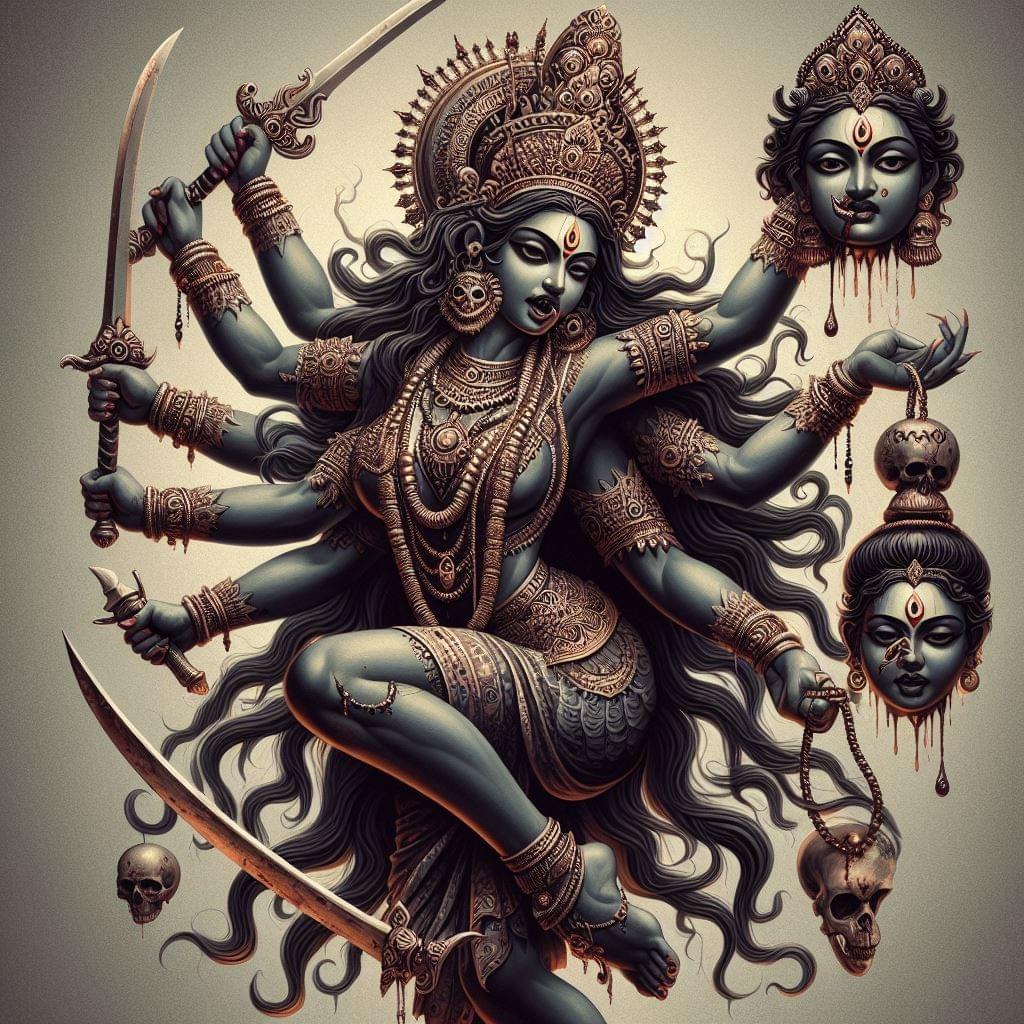
I have worked often with Sanskrit words in my auric/chakra work and have referred to the Khadroma as "Daughters of Kali Ma". From a traditional standpoint within Tibetan Vajrayāna Buddhism, Kha Dro Ma (Khadroma, Ḍākinī) are not typically referred to as “daughters of Kālī Ma.” That specific phrasing doesn’t appear in standard Tibetan liturgies or texts.
However, as an aspirant of Western Hermeticism if you take a broader Tantric or syncretic view that melds aspects of Indian Śākta Tantra (where Kālī is revered as the supreme Mother Goddess) with Tibetan Ḍākinī lore, you can see how someone might poetically describe the Kha Dro Ma as “daughters of Kālī Ma.” Here’s why:
1. Shared Tantric Roots
Indian Origins of the Word “Ḍākinī”
Before making its way into Tibetan Buddhism as Kha Dro Ma, the term “Ḍākinī” was already present in Indian Tantric traditions—both Buddhist and Hindu. In early Hindu Śākta Tantra (especially those devoted to Kālī or other fierce aspects of the Goddess), references to Ḍākinīs appear as supernatural feminine beings who embody divine or semi-divine energies.Goddess Kālī in Indian Tantra
- Kālī is revered as the fierce, liberating face of the Mahādevī (Great Goddess). She is often described as the ultimate embodiment of time, change, and the power of dissolution leading to renewal.
- In some of her retinues, Kālī is attended by Ḍākinīs, Ḍākinīs sometimes listed alongside Yoginīs and other semi-wrathful or ecstatic feminine spirits.
- From a Śākta perspective, these Ḍākinīs can be viewed as emanations, attendants, or “daughters” of the Great Goddess (Kālī) because they share her fierce, transformative energy.
2. Syncretic Parallels in Tibetan Buddhism
Manifestations of Feminine Wisdom
In Tibetan Vajrayāna, the Kha Dro Ma (Khandromas, Ḍākinīs) are embodiments of enlightened feminine wisdom, often associated with empty yet dynamic space—what one might call the boundless sky (mkha’). They can appear as fierce or wrathful guardians, peaceful guides, or blissful consorts to specific Buddhas or Bodhisattvas.Wrathful Compassion
The fierce iconography of certain Tibetan Ḍākinīs can be reminiscent of Kālī:- Skulls, fires, or severed heads can symbolize cutting through ego and delusion.
- Wrathful postures can be an expression of compassionate ferocity, which also underlies Kālī’s iconography in Hindu Tantra.
- Both Kālī and wrathful Ḍākinīs represent a protective yet transformative energy that destroys ignorance.
Syncretic Identification
When bridging the worlds of Indian Śākta Tantra and Tibetan Vajrayāna, a practitioner might interpret fierce Ḍākinīs as “aspects” or “emanations” of the same primordial feminine force that Kālī embodies. Although the traditions developed different systems and liturgies, the core “fierce mother” archetype resonates across these streams of Tantra.
3. Hermetic and Cross-Traditional Synthesis
Archetypes of the Dark Feminine
In Western esoteric work, the “dark feminine” archetype is present in figures such as Lilith, Hecate, or the Gnostic Sophia in her wrathful aspect. Likewise, in India you have Kālī or Chinnamastā, and in Tibetan Buddhism you have various wrathful Ḍākinīs. Each expresses the power of dissolution (tearing away old forms) and rebirth in a deeper truth.The ‘Daughters of Kālī’ as a Poetic Device
Referring to the Ka Dro Ma as “daughters of Kālī Ma” can be a poetic or mystical way of saying:- “These fierce wisdom-beings arise from (or are intimately connected to) the same cosmic feminine power that Kālī wields.”
- They share the same metaphysical ‘DNA’ of radical liberation, which can be both protective and destructive of what is false.
Caution with Cultural Boundaries
While syncretism can produce powerful spiritual insights, it is also important to recognize that the Ka Dro Ma in Vajrayāna practice follow unique transmissions, empowerments, and ritual contexts distinct from Kālī worship in Hindu Śākta Tantra. One can still honor the parallels without flattening or conflating the traditions entirely.
4. Seeing the Dakinis as ‘Daughters of Kālī Ma’—A Hermetic Reflection
- Kālī as the Primordial Womb: In a broad mystical sense, Kālī represents the womb of creation and destruction—“She who devours Time,” cutting through illusions of ego and mortality.
- Ḍākinīs as Agents of Her Power: If Kālī is the great cosmic Mother, then any fierce feminine emanation carrying out her function of transformation and liberation might be seen as her “daughter.” This idea emphasizes a lineage or emanation chain from the primordial mother to her retinue.
- Link to the Hermetic Binah: In Western Hermetic Qabalah, Binah is the Great Mother on the Tree of Life, with a dual face: nurturing and severe (the “dark Sterile Mother” aspect). Kālī’s and Ḍākinīs’ fierce aspects can be correlated with Binah’s severity and Saturnian influence—she breaks down form to create new life.
- Personal Devotional Practice: If you personally experience Kha Dro Ma as “Kālī’s daughters,” it can be a meaningful, devotional approach, so long as you hold it with respect for both the Tibetan and Indian Tantric lineages.
Conclusion
Calling the Ka Dro Ma (Khandroma, Ḍākinī) “daughters of Kālī Ma” is more of a poetic or mystical equivalence rather than a strictly traditional one. It captures the shared essence of the fierce, protective, and liberating feminine power seen in both Kālī and the wrathful/transformative aspects of Ḍākinīs. If done with reverence, this cross-traditional identification can enrich one’s personal spiritual practice by acknowledging the universal archetype of the Dark Mother and her fierce daughters who dance between destruction and rebirth, offering guidance and protection along the path of liberation.
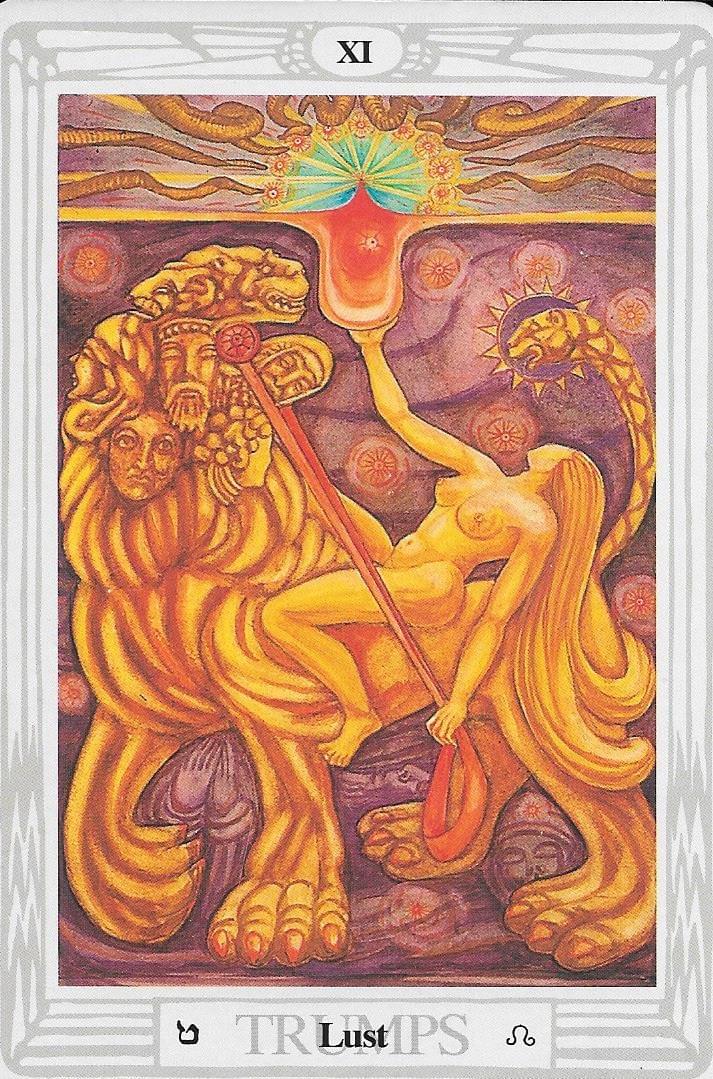
In The Western Hermetic Thoth Tarot-ATU 11 one can see parallels between Vajrayoginī and the “Scarlet Woman” featured on the Thoth Tarot’s Lust card (often identified with Babalon in Thelema). Both represent a potent, ecstatic feminine force capable of transforming raw, passionate energy into a vehicle for spiritual liberation. However, they arise from markedly different esoteric lineages—Tibetan Vajrayāna Buddhism vs. Thelemic Western Hermeticism—and thus each figure functions within its own symbolic and doctrinal framework.
Below is a more in-depth discussion:
1. The Scarlet Woman on the Thoth “Lust” Card
Crowley’s Redefinition of “Strength”
- In the Rider-Waite-Smith Tarot, Atu (Major Arcana) XI is called Strength—traditionally depicting a maiden calming a lion. In Aleister Crowley’s Thoth Tarot, the card is re-named Lust, signifying not mere physical desire but a supreme courage and ecstatic power that surges from harnessing Will (Thelema) and the vital energies of Life.
- The woman on the beast is sometimes equated with the “Whore of Babylon” of Revelation, which Crowley reworked and exalted as Babalon—the goddess of Thelema, representing the free-flowing sexual/spiritual force that beckons the magician to surrender to (and unite with) the All.
Symbolic Characteristics
- Scarlet Woman / Babalon: Embodies radical freedom, spiritual ecstasy, and the alchemy of desire. She receives all, transforms all. She can be fierce, destructive of egoic boundaries, yet also liberating.
- The Beast: She rides the Beast of primal power—an image of raw, manifest energy (akin to the id or unbridled force). Alchemically, it’s the base matter that is transmuted by the marriage of Will and Love.
Transforming Lust into Light
- Crowley, drawing from Tantric notions, taught that powerful energies (particularly sexual) can be a direct path to spiritual awakening if directed by True Will and divine insight. This is an “East-meets-West” approach, but thoroughly recast in Thelemic ideology.
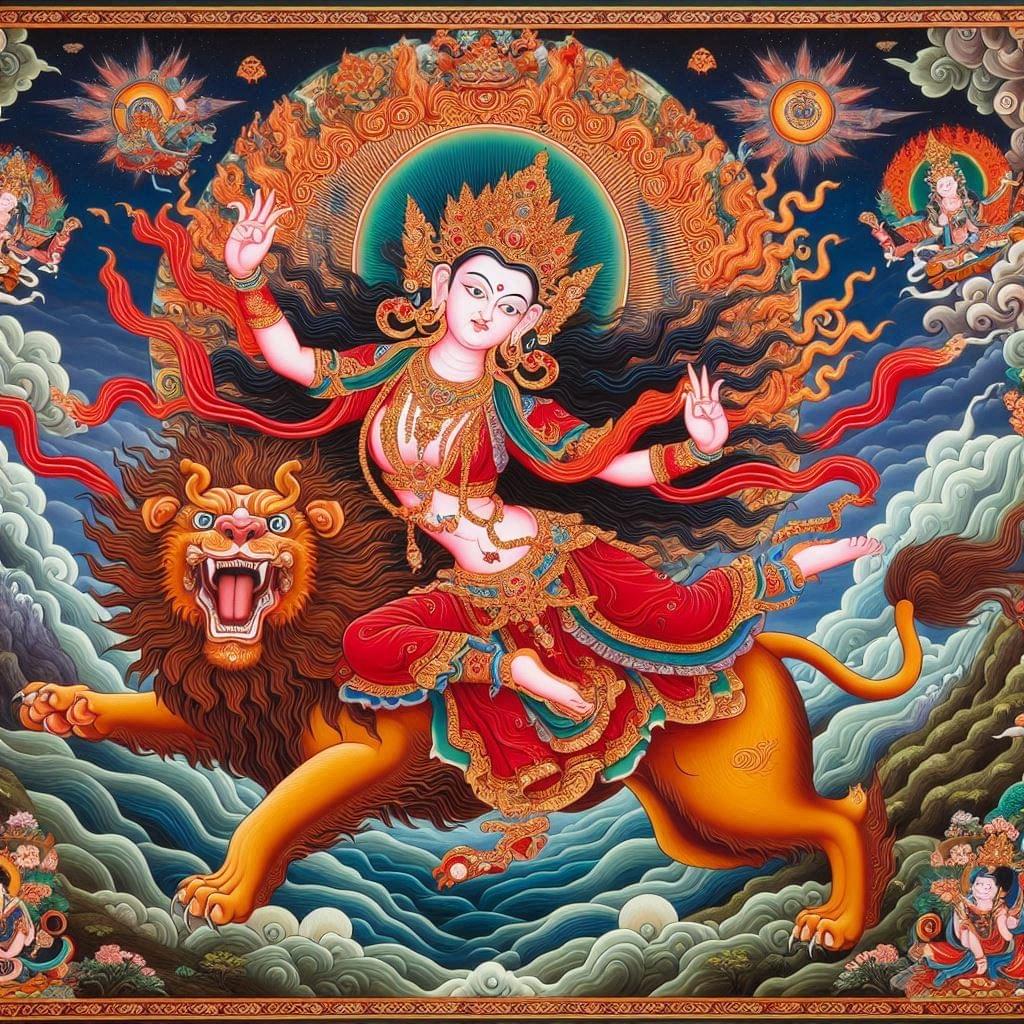
2. Vajrayoginī in Tibetan Vajrayāna Buddhism
Supreme Ḍākinī
- Vajrayoginī (the “Dancing Red Yoginī”) is often regarded as the quintessential Ḍākinī, embodying enlightened feminine energy. She is shown in a dancing posture, with a fierce yet blissful expression, typically red in color.
- Her practice is intended to transform passionate desire into wisdom, annihilating dualistic clinging and swiftly leading the practitioner to realize the nature of emptiness (Śūnyatā) suffused with bliss.
Wrathful Yet Compassionate
- Wrathful iconography (skulls, a flaying knife, severed heads) symbolizes the destruction of ignorance, ego, and illusions. However, the wrath is deeply compassionate—aimed at awakening beings to their true nature.
- She is not “lustful” in the profane sense; rather, her sensual or erotic imagery is a Tantric method to transmute ordinary desire into Mahāsukha (great bliss) integrated with emptiness-wisdom.
Lineage and Initiation
- In Vajrayāna, Vajrayoginī is approached through initiation (empowerment), structured sādhanas, and guidance from a qualified lama. She represents a complete path to enlightenment, replete with specific meditations, mantras, and visualization techniques.
3. Points of Resonance
Harnessing Desire
- Scarlet Woman / Babalon: Emphasizes embracing one’s True Will and channeling sexual-spiritual energy toward union with the divine.
- Vajrayoginī: Emphasizes transforming the energy of passion/desire into wisdom-realization.
- Commonality: Both highlight a form of divine eros (fiery, ecstatic force) that, when consciously directed, furthers the aspirant’s spiritual evolution.
Ecstasy and Transformation
- The Lust card depicts a state of rapture, intoxication, or ecstasy—suggesting a union that destroys the ego’s constraints.
- Vajrayoginī’s practice involves ecstatic aspects too, often referred to as “bliss-emptiness” experiences, dissolving conceptual boundaries in luminous awareness.
Feminine Archetype
- Both represent a fierce, liberating feminine principle. The Scarlet Woman drinks from the Cup of Abominations and transforms all, while Vajrayoginī chops off illusions and drinks from a skull-cup of blood (symbolizing severed ego).
- Despite differences in religious worldview, they each stand for a dynamic, red, transformative feminine energy bridging desire and enlightenment.
4. Key Distinctions
Ontological Context
- Tibetan Buddhism: Vajrayoginī arises in the context of Buddhahood, which includes emptiness (śūnyatā), compassion (karuṇā), and renunciation (of ego-based clinging).
- Thelema / Western Hermeticism: Babalon is linked to the Book of the Law (Liber AL vel Legis) and the concept of True Will, with focus on self-realization through personal gnosis and the melding of mystical and magickal attainment.
Purpose of Practice
- Vajrayoginī: To realize complete enlightenment—cessation of suffering through awakening to the empty, luminous nature of mind.
- Scarlet Woman: A symbol to push the magician beyond moral, social, and psychological limits, fully manifesting their Will and uniting with the infinite in a Thelemic sense.
Sacred vs. Profane
- While both use erotic or passionate imagery, they do so within different doctrinal scaffolding. A direct one-to-one mapping (e.g., “Vajrayoginī = Babalon exactly”) risks overlooking how each tradition specifically frames and “codes” these energies.
5. Hermetic-Syncretic Perspective
For a practitioner who works both with Thelema and has exposure to Vajrayāna concepts:
Archetypal Convergence
- You could see Vajrayoginī as an Eastern expression of what the Thoth Lust card’s Scarlet Woman embodies: the raw, transformative power of primal desire harnessed for spiritual liberation.
- Both emphasize the idea that divine ecstasy (or bliss) arises when desire is penetrated by higher insight—be that non-dual wisdom or True Will.
Cultural and Ritual Respect
- Vajrayoginī sādhanas are structured, lineage-based Tibetan practices requiring proper empowerment.
- The Scarlet Woman is part of a Thelemic current that has its own initiatory and ritual framework.
- Respecting each tradition’s integrity while noting archetypal parallels helps maintain genuine depth rather than superficial mixing.
Possible Internal Synthesis
- On an inner level, a Western magician might find that meditating on the Lust card or invoking Babalon resonates with the same fundamental energy that Vajrayoginī sādhanas harness: a fierce grace that devours illusions and births higher awareness.
Conclusion
Can Vajrayoginī be compared to the Scarlet Woman (Babalon) on the Thoth Lust card?
- Yes, in the sense that both are archetypes of a powerful, liberating feminine force, utilizing passion or “lust” (broadly defined) as a route to transcendence and higher consciousness.
- No, if we conflate or ignore their distinct doctrinal frameworks: Vajrayāna Buddhism vs. Thelema. Each tradition carries deep and unique metaphysical assumptions, ritual contexts, and spiritual aims.
Nonetheless, for those engaged in cross-traditional exploration, the parallel can be a profound personal insight into the universal theme of feminine potency, ecstatic wisdom, and the alchemy of desire.
The Ritual of Invocation.
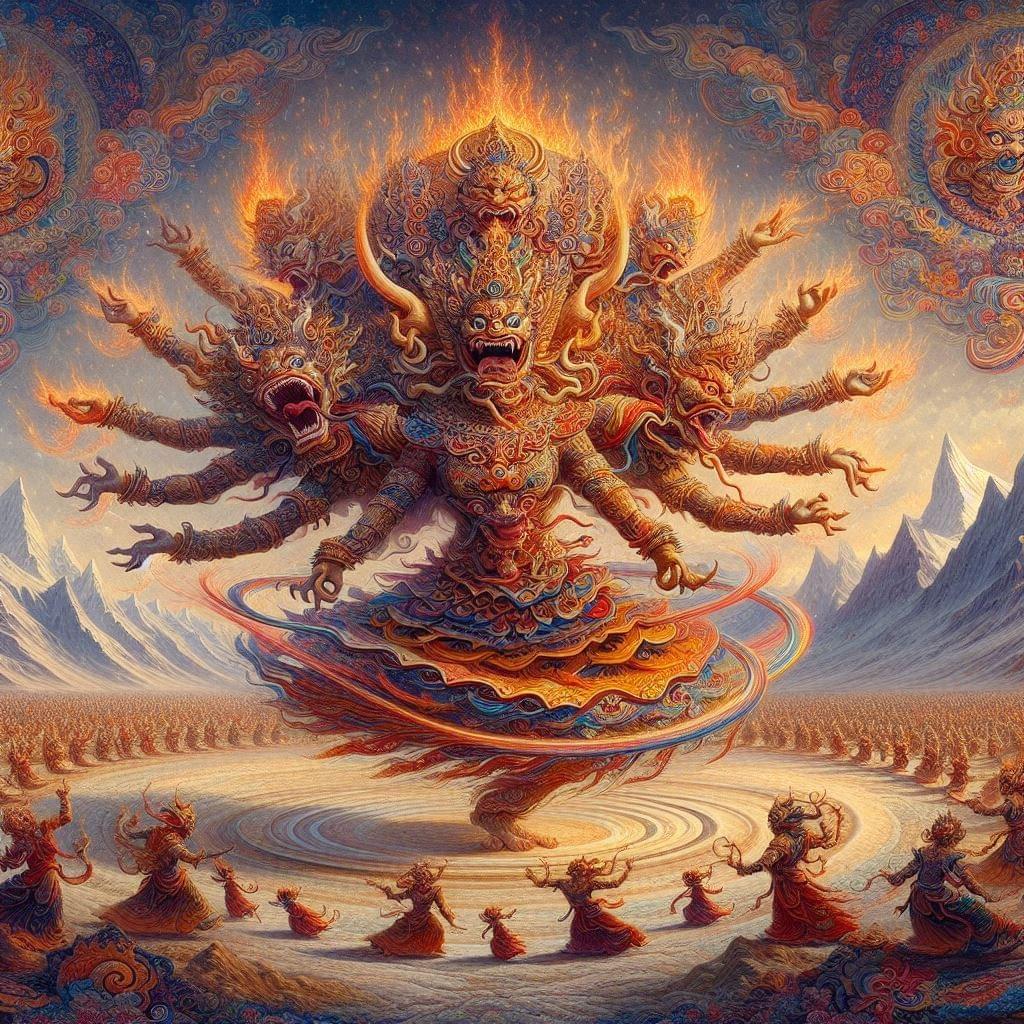
Western Hermetic Invocation of the Ka Dro Ma for fierce guardianship
Below is a suggested framework for practitioners who wish to integrate a Ka Dro Ma invocation into a ritual structure reminiscent of the Western Hermetic tradition (e.g., Golden Dawn-inspired or similar). You can adapt or refine any part of this to match your personal style, lineage, or symbolic system.
Preliminary Considerations
- Ethical Approach: Understand that Ka Dro Ma belong to a specific Vajrayāna context. In bridging traditions, act with reverence. You are seeking to honor them rather than impose a foreign system on them.
- Magical Cleansing: In Western Hermetic practice, one typically begins with a banishing or purification rite (such as the Lesser Banishing Ritual of the Pentagram, or another cleansing ceremony of your choice). This sets a clear energetic space for safe contact.
- Tools and Correspondences:
- Incense: Frankincense, sandalwood, or Tibetan incense if available—something that resonates with a sense of purification and invocation of higher forces.
- Altar Setup: A central candle or lamp signifying enlightened awareness. Optionally place images or symbolic representations of Ka Dro Ma or Ḍākinī forms if you have them. If you have crystal skulls or a skull you may wish to add this to your altar.
- Offering Bowl: In many Vajrayāna practices, offerings of water, flowers, or rice are used. In a Hermetic adaptation, you might have a bowl of water and salt combined (representing the alchemical union of elements) to symbolize your sincere offering of hospitality.
Step-by-Step Ritual
Opening and Purification
- Banishing: Perform your preferred banishing ritual (e.g., the LBRP).
- Declaration: Stand facing east (or your chosen cardinal direction to open the ritual). State:
“I stand within the Light of the Eternal. May all unclean or harmful influences depart. By the Light of the Divine, I consecrate this space as a meeting ground of Heaven and Earth.”
Invocation of Higher Guidance
- Centering: Close your eyes, breathe deeply, and center in your heart. Visualize a sphere of pure white or golden light enveloping you.
- Alignment: You may call upon your Highest Self, Holy Guardian Angel, or your concept of the Divine to oversee the ritual. For instance:
“I invoke the guidance of my Holy Guardian Angel / the Divine Light / the highest aspect of my being. Let all be in accordance with True Will and compassion.”
Call to the Ka Dro Ma
- Visualizing the Ka Dro Ma: Form an image in your mind’s eye of luminous feminine figures dancing in sky-like space—sometimes wrathful, sometimes peaceful, radiating a fierce compassion that both protects and enlightens.
- Vibratory Words or Sacred Names (Optional): Since Ka Dro Ma are Tibetan in origin, you might use a short mantra associated with Ḍākinīs. A commonly used seed syllable is PHEM (similar to PHAT for wrathful clearing), though you might also intone AH or HUM to invoke Ḍākinī energy. If you do not have a specific Ḍākinī mantra, you can simply chant a clear tone, focusing your intention on calling the Ka Dro Ma.
- Verbal Invocation: Aloud, speak words to invite their presence:
“From the limitless expanse of pristine awareness,
O Ka Dro Ma—Sky Dancers of the Vajrayāna,
Guardians of the liminal realms,
Bearers of wisdom’s fierce compassion—
I call upon you to be present in this sacred space.
Unveil your protective power;
Shield me from harmful influences.
Lead wandering souls to peaceful rest;
Guide me in the ways of transformation and liberation.
May your sky-like freedom descend upon me,
And may our union serve the Highest Good.”
Petition and Intent
- State Your Purpose: Clearly articulate the reason you seek their presence—whether for protection, for assisting spirits (psychopomp work), or for personal insight. In Western Hermetic style, it is helpful to be specific:
“I ask your assistance in __ (state your spiritual or protective aim) __.
May my intention be pure, my will aligned with compassion,
And my actions conducive to liberation for all beings.”
- State Your Purpose: Clearly articulate the reason you seek their presence—whether for protection, for assisting spirits (psychopomp work), or for personal insight. In Western Hermetic style, it is helpful to be specific:
Offering and Expression of Gratitude
- Physical Offering: Lift your offering bowl, incense, or candle flame.
“I offer this incense / flame / water as a gesture of respect and gratitude.
May it be received as a token of my devotion and sincerity.” - Inner Offering: Visualize the radiant light of your heart going forth, merging with the luminous presence of the Ka Dro Ma.
- Pause and Listen: Remain still for several moments, sensing any shift in energy, presence, or insight.
- Physical Offering: Lift your offering bowl, incense, or candle flame.
Guidance or Working
- If you have a particular working—such as guiding a lost spirit to the Light, or empowering your protective wards—this is where you focus on that process. Visualize the Ka Dro Ma assisting you, clearing obstacles, or ferrying souls forward in compassion.
Closing and License to Depart
- Words of Thanks:
“O Ka Dro Ma, I give thanks for your presence and your aid.
May our connection endure in peace, wisdom, and compassion.” - License to Depart: In Western magic, you give the energies permission to depart or remain as they see fit, without binding them:
“Return now to your realms of sky and light,
Or stay if it be your will,
Ever welcome in this sacred space.
I release you in freedom—may there be peace between us now and always.” - Final Banishing or Grounding: Conclude with a short banishing, or ground yourself by stamping your feet on the floor and thanking the elements. This ensures you return to ordinary awareness in a stable manner.
- Words of Thanks:
Integration
- Reflection: Journal or note any impressions, visions, or feelings you received during the ritual.
- Continued Practice: If you plan to work with the Ka Dro Ma more consistently, consider offering a brief prayer or acknowledgement to them in your daily practice. This helps cultivate a genuine relationship over time.
Further Notes on Syncretism
- Respect for Tibetan Methods: Traditionally, one would receive empowerment or authorization in Vajrayāna to engage with Ḍākinī practices. In a purely personal, syncretic approach, heartfelt respect and humility are crucial—recognizing that there is a vast body of Tibetan teachings and lineage transmissions behind these forms.
- Western Hermetic Parallels: In the Hermetic Qabalistic tradition, we find references to angelic or elemental forces that embody protective or transformative energies. You may find parallels by exploring the Shekinah (Divine Feminine Presence in Qabalah) or certain archangelic powers. However, Ka Dro Ma remain a unique category of wisdom protectors and wrathful/peaceful guides in their own Tibetan context.
- Maintain Inner Alignment: The most important factor in any ritual is the sincerity of the practitioner’s heart and mind. Whether using Tibetan mantras, Western divine names, or a hybrid approach, approach the Ka Dro Ma with love, respect, and clarity of purpose.
Conclusion
By combining Tibetan insights about Ka Dro Ma as protectors and psychopomps with a Western Hermetic ritual framework, one can create a heartfelt syncretic practice. Always remember that these traditions have deep lineages, so humbly honoring their origins will strengthen your ritual’s integrity. May this guidance serve as a respectful pathway to connect with the powerful and liberating energies of the Ka Dro Ma.
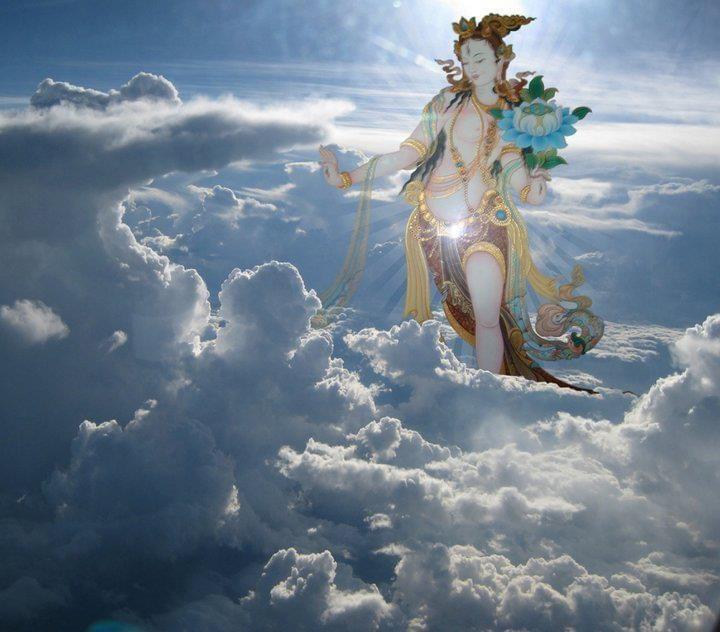
Thank you for your interest, comments and supportive donations that keep this site working. May you live long and prosper.
3 Western Hermetic Magick websites that have been helping people become more magick and less tragic since 2010.
Traditional Tarot card comparisons, tarot layout store and blog.
Western Hermetic Thoth Tarot card comparisons. tarot layout store and blog.
Western Hermetic Magick invocations and rituals and magick blog.
